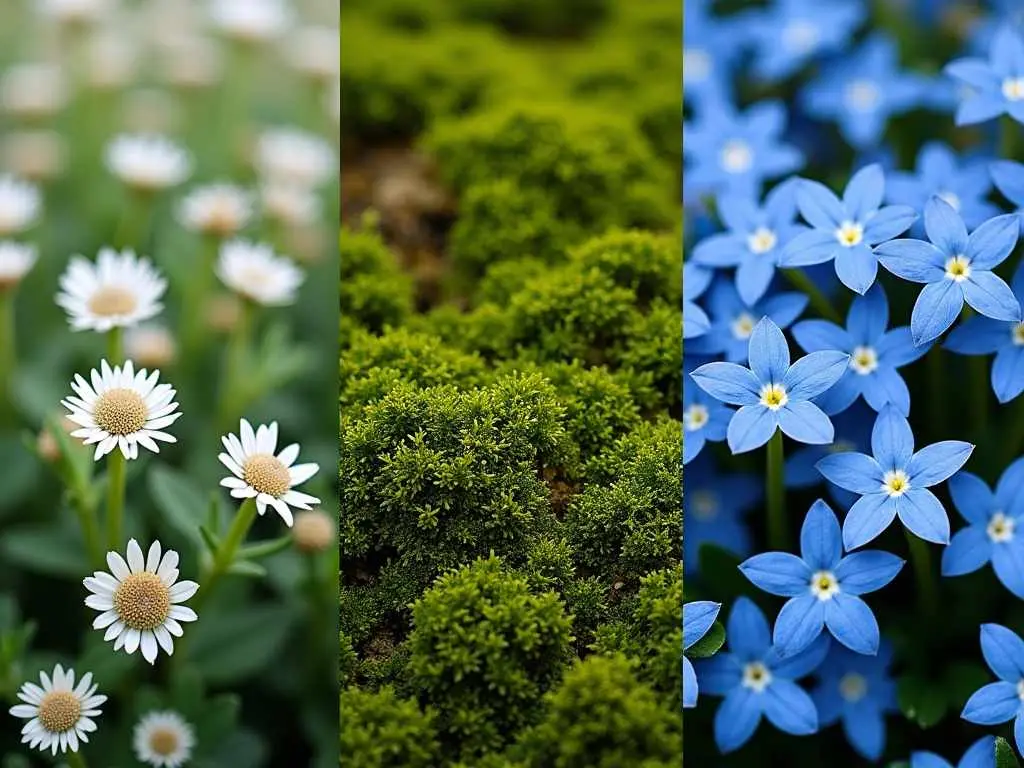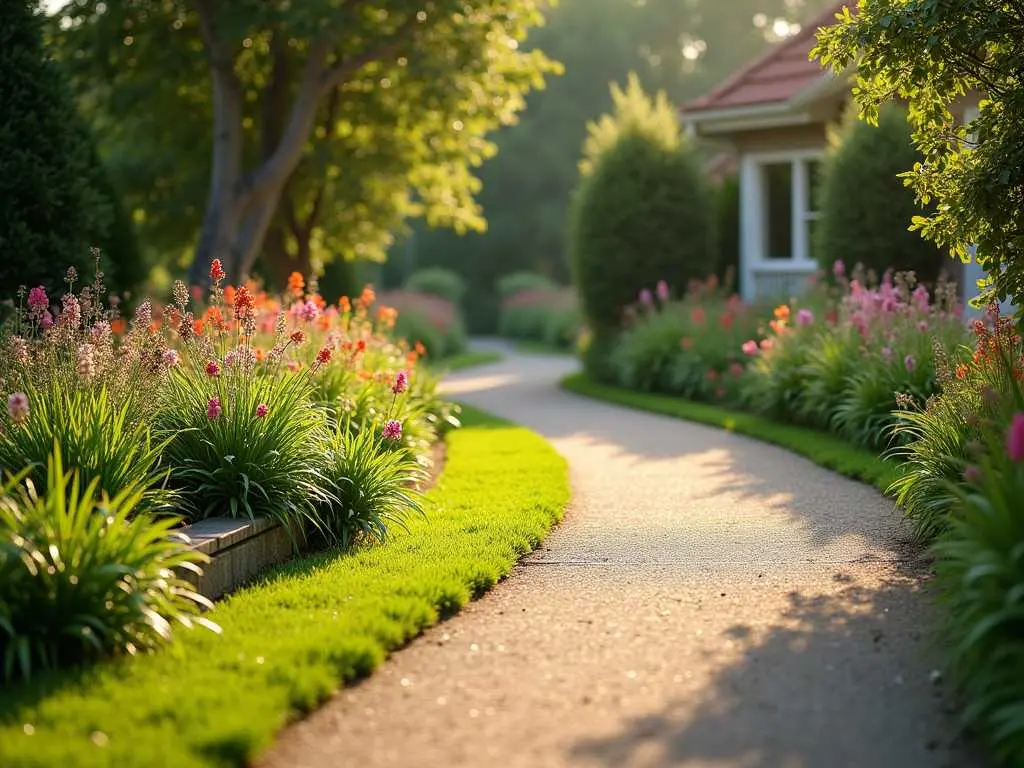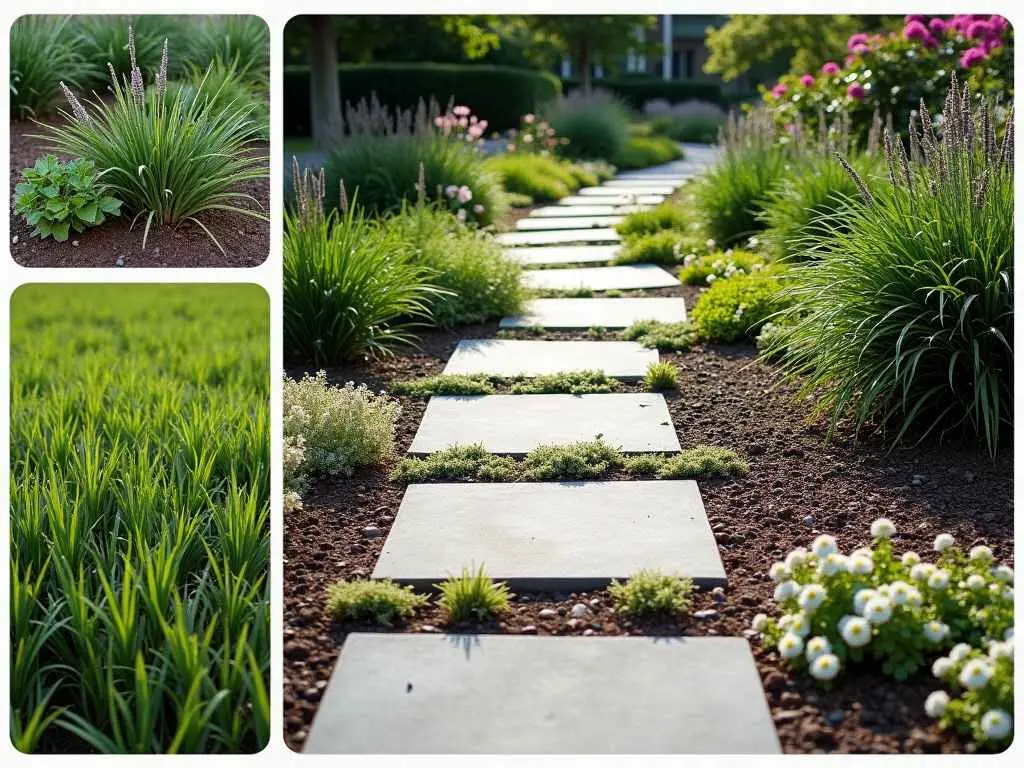As a seasoned landscape architect with over two decades of experience designing award-winning gardens, I’ve cultivated a deep understanding of how to transform ordinary walkways into captivating pathways. My expertise in plant selection and placement has been recognized by leading horticultural societies, and I’m excited to share my knowledge to help you create stunning walkway borders that will elevate your outdoor space.
Jump to:
The Importance of Walkway Borders
Walkway borders play a crucial role in defining the aesthetic and functionality of your garden. They not only guide visitors through your outdoor space but also create visual interest and soften the transition between hardscaping and the surrounding landscape. Well-designed borders can enhance the overall appeal of your property, increase curb appeal, and even contribute to biodiversity by providing habitats for beneficial insects and wildlife.
Choosing the Right Plants for Your Walkway Border
When selecting plants for your walkway border, consider the following factors:
- Climate and sun exposure
- Soil type and drainage
- Maintenance requirements
- Height and spread at maturity
- Seasonal interest
- Compatibility with existing landscaping
Let’s explore some of the best plant options for creating stunning walkway borders, categorized by their growth habits and characteristics.
Low-Growing Ground Covers

Ground covers are excellent choices for walkway borders, as they create a lush carpet effect and help suppress weeds. Here are some top picks:
1. Creeping Thyme (Thymus serpyllum)
Creeping thyme is a versatile and aromatic ground cover that thrives in full sun to partial shade. Its low-growing habit and ability to withstand light foot traffic make it ideal for walkway borders.
Key features:
- Height: 2-4 inches
- Spread: 12-18 inches
- Bloom time: Late spring to early summer
- Flower colors: Pink, purple, or white
Care tips: Plant in well-draining soil and water regularly until established. Trim after flowering to maintain shape.
2. Irish Moss (Sagina subulata)
Despite its name, Irish moss is not a true moss but a low-growing perennial that forms a dense, carpet-like mat. It’s perfect for creating a lush, green border along shaded walkways.
Key features:
- Height: 1-2 inches
- Spread: 12-18 inches
- Bloom time: Late spring
- Flower color: White
Care tips: Prefers moist, well-draining soil and partial to full shade. Water regularly during dry spells.
3. Blue Star Creeper (Isotoma fluviatilis)
This low-maintenance ground cover produces delicate blue flowers that add a touch of color to walkway borders. It’s adaptable to various light conditions, making it suitable for both sunny and partially shaded areas.
Key features:
- Height: 2-3 inches
- Spread: 12-18 inches
- Bloom time: Late spring to early fall
- Flower color: Pale blue
Care tips: Plant in well-draining soil and water regularly. Trim as needed to maintain desired shape.
Ornamental Grasses
Ornamental grasses add texture, movement, and year-round interest to walkway borders. Here are some excellent choices:
4. Blue Fescue (Festuca glauca)
Blue fescue is a compact, mounding grass with striking blue-gray foliage. Its neat habit makes it an excellent choice for creating a uniform border along walkways.
Key features:
- Height: 6-12 inches
- Spread: 6-12 inches
- Bloom time: Early summer
- Foliage color: Blue-gray
Care tips: Plant in full sun to partial shade and well-draining soil. Divide clumps every 2-3 years to maintain vigor.
5. Japanese Forest Grass (Hakonechloa macra)
This elegant grass forms graceful, arching mounds that add a touch of sophistication to shaded walkway borders. Its variegated cultivars, such as ‘Aureola’, provide additional visual interest.
Key features:
- Height: 12-18 inches
- Spread: 18-24 inches
- Bloom time: Late summer
- Foliage color: Green or variegated
Care tips: Plant in partial to full shade and moist, well-draining soil. Cut back in late winter before new growth emerges.
Flowering Perennials
Incorporating flowering perennials into your walkway border adds bursts of color and attracts pollinators. Consider these options:
6. Lavender (Lavandula angustifolia)
Lavender is a classic choice for walkway borders, offering fragrant foliage and beautiful purple blooms. Its compact habit and drought tolerance make it low-maintenance and visually appealing.
Key features:
- Height: 1-3 feet
- Spread: 1-3 feet
- Bloom time: Summer
- Flower color: Purple
Care tips: Plant in full sun and well-draining soil. Prune lightly after flowering to maintain shape.
7. Catmint (Nepeta x faassenii)
Catmint is a versatile perennial that produces masses of lavender-blue flowers above aromatic gray-green foliage. It’s an excellent choice for attracting pollinators and creating a soft, informal border.
Key features:
- Height: 1-2 feet
- Spread: 1-2 feet
- Bloom time: Late spring to fall
- Flower color: Lavender-blue
Care tips: Plant in full sun to partial shade and well-draining soil. Cut back after the first flush of blooms to encourage reblooming.
8. Echinacea (Coneflower)
Echinacea, or coneflower, is a hardy perennial that adds height and vibrant color to walkway borders. Its daisy-like flowers come in various shades and attract butterflies and bees.
Key features:
- Height: 2-4 feet
- Spread: 1-2 feet
- Bloom time: Summer to fall
- Flower colors: Purple, pink, white, yellow, or orange
Care tips: Plant in full sun and well-draining soil. Deadhead spent blooms to encourage continuous flowering.
Evergreen Shrubs
Incorporating evergreen shrubs into your walkway border provides year-round structure and interest. Here are some excellent choices:
9. Boxwood (Buxus spp.)
Boxwood is a classic choice for formal walkway borders. Its dense, evergreen foliage can be easily shaped and maintained, making it perfect for creating clean lines and defined edges.
Key features:
- Height: 1-3 feet (dwarf varieties)
- Spread: 1-3 feet
- Foliage color: Dark green
Care tips: Plant in full sun to partial shade and well-draining soil. Prune regularly to maintain desired shape.
10. Dwarf Mugo Pine (Pinus mugo var. pumilio)
This compact evergreen shrub adds texture and winter interest to walkway borders. Its slow growth rate and dense habit make it an excellent low-maintenance option.
Key features:
- Height: 2-4 feet
- Spread: 3-5 feet
- Foliage color: Dark green
Care tips: Plant in full sun and well-draining soil. Prune new growth in spring to maintain compact shape.
Designing Your Walkway Border

When designing your walkway border, consider the following tips:
- Create layers: Combine plants of varying heights, textures, and colors to add depth and visual interest.
- Repeat patterns: Use repetition of plants or colors to create a cohesive look along the walkway.
- Consider seasonality: Choose plants that offer interest throughout the year, such as spring-blooming bulbs, summer perennials, and evergreen shrubs.
- Mind the proportions: Ensure that the border plants don’t overwhelm the walkway. A general rule of thumb is to keep the border width about one-third the width of the path.
- Plan for growth: Account for the mature size of plants when spacing them to avoid overcrowding.
Plant Popularity for Walkway Borders

Data source: American Society of Landscape Architects (ASLA) Annual Survey, 2023
Maintenance Tips for Walkway Border Plants
To keep your walkway border looking its best, follow these maintenance tips:
- Regular watering: Most border plants benefit from consistent moisture, especially during establishment and dry periods.
- Mulching: Apply a 2-3 inch layer of organic mulch around plants to conserve moisture, suppress weeds, and regulate soil temperature.
- Pruning and deadheading: Regularly remove dead or damaged foliage and spent blooms to encourage healthy growth and continuous flowering.
- Fertilizing: Apply a balanced, slow-release fertilizer in spring to promote healthy growth throughout the season.
- Dividing perennials: Divide overcrowded perennials every 3-5 years to maintain vigor and prevent them from outgrowing their space.
- Weed control: Remove weeds regularly to prevent competition for resources and maintain a tidy appearance.
Maintenance Time for Different Plant Types

Data source: Royal Horticultural Society (RHS) Garden Care Study, 2022
Sustainable Practices for Walkway Border Plantings
Incorporating sustainable practices into your walkway border design not only benefits the environment but can also reduce maintenance and resource requirements. Consider the following approaches:
- Native plant selection: Choose plants native to your region, as they are adapted to local conditions and require less water and maintenance.
- Water-wise design: Group plants with similar water needs together and consider incorporating drought-tolerant species to reduce water consumption.
- Integrated pest management: Use natural pest control methods and encourage beneficial insects to maintain a healthy ecosystem.
- Composting: Incorporate compost into your soil to improve fertility and reduce the need for synthetic fertilizers.
- Rainwater harvesting: Consider installing a rain barrel or other water collection system to use for irrigation during dry periods.
Water Consumption by Plant Type

Data source: Environmental Protection Agency (EPA) WaterSense Program, 2023
People Also Ask
Q: How far apart should I plant my walkway border plants?
A: The spacing depends on the mature size of the plants. Generally, space low-growing ground covers 6-12 inches apart, perennials 12-18 inches apart, and shrubs 2-3 feet apart. Always check the plant’s specific requirements and account for its mature spread.
Q: Can I mix different types of plants in my walkway border?
A: Yes, mixing different types of plants can create a more dynamic and interesting border. Combine plants with varying heights, textures, and bloom times to create visual interest throughout the seasons. Just ensure that all chosen plants have similar growing requirements.
Q: How do I prevent my walkway border plants from spreading into the path?
A: Install edging materials such as plastic, metal, or stone along the border to create a physical barrier. Regularly trim and maintain plants to keep them within bounds. Choose plants with a compact growth habit or slow-growing varieties to minimize spreading.
Conclusion
Creating stunning walkway borders with the right plant selection can transform your outdoor space into a captivating and inviting environment. By considering factors such as climate, maintenance requirements, and design principles, you can craft beautiful, low-maintenance borders that enhance your property’s aesthetic appeal and functionality. Remember to incorporate sustainable practices and regular maintenance to ensure your walkway borders thrive for years to come.
References
- American Society of Landscape Architects. (2023). Annual Survey on Landscape Design Trends. Retrieved from https://www.asla.org/survey2023
- Royal Horticultural Society. (2022). Garden Care Study: Maintenance Requirements for Popular Garden Plants. Retrieved from https://www.rhs.org.uk/science/gardencarest
- Environmental Protection Agency. (2023). WaterSense Program: Water-Efficient Landscaping. Retrieved from https://www.epa.gov/watersense/landscaping-tips
Disclosure
Our content is reader-supported. This means if you click on some of our links, then we may earn a commission. Commissions do not affect our editor’s opinions or evaluations. Learn more about our editorial process.

About the Editorial Staff
The Curvspace editorial team comprises a diverse group of experts on intermediate and threshold spaces in homes and workplaces. Architects and interior designers, civil engineers and artists, environmental and behavioral psychologists, sociologists and anthropologists. All collaborate to create helpful content, that explores the full potential of these often-overlooked areas to enhance our daily lives.


